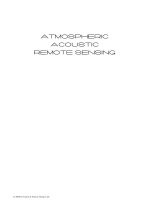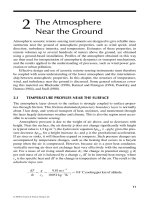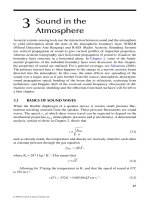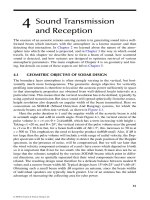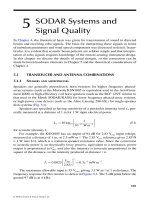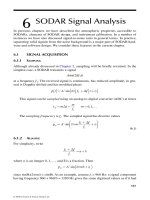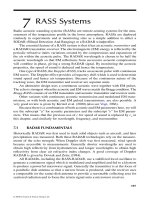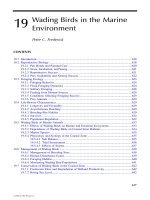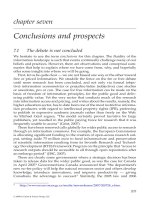Atmospheric Acoustic Remote Sensing - Chapter 8 (end) pot
Bạn đang xem bản rút gọn của tài liệu. Xem và tải ngay bản đầy đủ của tài liệu tại đây (1.41 MB, 49 trang )
213
8
Applications
This book is primarily about the design and operating principles of atmospheric
acoustic remote-sensing instruments, so this chapter will simply give a few examples
of the use to which this technology can be put. For a more exhaustive insight into
applications, there are very good review articles such as Singal (1997), Asimakopou-
los (1994), Asimakopoulos and Helmis (1994), Asimakopoulos et al. (1996), Engel-
bart (1998), Reitebuch and Emeis (1998), Coulter and Kallistratova (1999), Engelbart
et al. (1999), Helmis et al. (2000), Kirtzel et al. (2000), Melas et al. (2000), Ostashev
and Wilson (2000), Seibert et al. (2000), Emeis (2001), Engelbart and Steinhagen
(2001), Piringer and Baumann (2001), Raabe et al. (2001), Rufeux and Stübi (2001),
Neisser et al. (2002), Peters and Fischer (2002), Anderson (2003), and Bradley et al.
(2004b).
8.1 REVIEW OF SELECTED APPLICATIONS
8.1.1 E
NVIRONMENTAL RESEARCH
A major use of SODAR and RASS technology is in monitoring and understanding
the atmospheric boundary layer in relation to air pollution and dispersion modeling.
Traditionally it has been difcult for these instruments to work effectively in closely
built-up urban areas, because of echoes from buildings and because of impact on
residents, but this is changing as the acoustic design of the instruments improves.
We give here a few results from Salfex, an urban “street canyon” momentum and
heat ux study in Salford, Greater Manchester, UK, which was led by Janet Bar-
low of Reading University (Barlow et al.,
2007).
Figure 8.1 shows a site plan of the
street canyon study area and the SODAR
location. The SODAR was placed on the
other side of the River Irwell, with rela-
tively open land upwind to the north, but
within 30 m of occupied housing to the
east. Directly measuring instrumentation
included masts extending to just above
the dense housing in the study area,
and the AeroVironment 4000 SODAR
provided data above that height. In this
way, wind proles could be obtained at
regular intervals, such as the half-hourly
proles shown in Figure 8.2.
FIGURE 8.1 Site plan for the Salfex cam-
paign. The street canyon measurements were
at site 1, and the SODAR at site 2. The plot is
1 km on each edge.
3588_C008.indd 213 11/20/07 4:15:05 PM
© 2008 by Taylor & Francis Group, LLC
214 Atmospheric Acoustic Remote Sensing
Estimates of roughness length in the complex surface of the streets and buildings
were readily available, as shown in the example of Figure 8.3.
The lowest points, at z–d = 12 m (with d = 8 m) represented the lowest height
accessible to the SODAR (because of ringing within the bafe). The roughness
length z
0
, friction velocity u
*
, and drag coefcient (u
*
/v)
2
all show variation with wind
direction. This is not surprising given the clearer sectors, but it would be difcult to
quantify these variations with any other instrument than a SODAR.
Second-moment data, such as the results for T
u,v
/T
w
shown in Figure 8.4, indicate
a change in the boundary layer regime at about 80 m. It is the interpretation of this
0
20
40
60
80
100
120
225 230 235 240 245 250 255 260 265 270
Wind Direction (degrees)
Height z (m)
10:30
11:00
11:30
12:00
12:30
13:00
13:30
14:00
FIGURE 8.2 :LQGGLUHFWLRQSURÀOHVUHFRUGHGHYHU\KDOIKRXU
2
2.5
3
3.5
4
4.5
5
5791113
Wind Speed V (m s
–1
)
20
40
30
100
70
50
Height z (m)
10:30
11:00
11:30
12:00
12:30
13:00
13:30
14:00
FIGURE 8.3 /RJDULWKPLFZLQGVSHHGSURÀOHVPHDVXUHGHYHU\KDOIKRXU
3588_C008.indd 214 11/20/07 4:15:07 PM
© 2008 by Taylor & Francis Group, LLC
ln (z-d) (m)
Applications 215
type of observed feature which is particularly useful in guiding the development of
new models for this challenging area of meteorology.
8.1.2 BOUNDARY LAYER RESEARCH
The use of an array of SODARs presents some interesting measurement opportuni-
ties. These include being able to investigate advection of non-turbulent structures.
The SABLE SODAR array (Bradley et al., 2004b; Bradley and von Hunerbein,
2006) consisted of four vertically pointing speaker-dish units having individual
power ampliers and local intelligence. They were interconnected via RS485 operat-
u,v
w
z
FIGURE 8.4 Second moment proles. o
u
/o
w
(diamonds), T
v
/ T
w
(squares).
Simpson
Red
Green
Blue
Yellow
226 m
225 m
389 m
394 m
387 m
224 m
+
+
+
+
+
+
+
+
+
FIGURE 8.5 The geometry of the Antarctic SODAR array.
3588_C008.indd 215 11/20/07 4:15:09 PM
© 2008 by Taylor & Francis Group, LLC
216 Atmospheric Acoustic Remote Sensing
ing at 57.6 kB and exchanged data with a centralized PC. SODAR spacing was about
400 m (Figure 8.5). The SODARs transmitted simultaneously in non-overlapping
frequency bands, but with center frequency, pulse characteristics, sampling, and
other parameters selectable on a pulse-by-pulse basis. Local control was achieved
with microprocessors. The array comprised three SODARs placed at the vertices of
an equilateral triangle, and a fourth SODAR at the center. Figure 8.6 shows typical
200
150
100
Height
50
0
678910
Time
11 12 13 14
200
150
100
Height
50
0
678910
Time
11 12 13 14
200
150
100
Height
50
0
678910
Time
11 12 13 14
200
150
100
Height
50
0
678910
Time
11 12 13 14
FIGURE 8.6 6HHFRORULQVHUWIROORZLQJSDJH3ORWVRIWLPHYDULDWLRQVRIWKH C
T
2
ÀHOG
measured by the four SODARs.
3588_C008.indd 216 11/20/07 4:15:11 PM
© 2008 by Taylor & Francis Group, LLC
Applications 217
time series of C
T
2
proles. Fluctuations in
C
T
2
occur at each range gate level, and
these are often correlated across the four SODARs because of advected coherent
structures. Covariances were computed at each height for each pair of SODARs
and from these the corresponding time lags were estimated. This resulted in a sys-
tem of linear equations to be solved for the advected velocity components (u, v), as
follows.
ˆ
,
,
,
,
,
,
u
x
x
x
x
x
x
yr
gr
gy
br
by
bg
$
$
$
$
$
$
§
©
¨
¨
¨
¨
¨
¨
¨
¨
¨
¨¨
¨
¨
·
¹
¸
¸
¸
¸
¸
¸
¸
¸
¸
¸
¸
¸
ˆ
,
,
,
,
v
y
y
y
y
y
yr
gr
gy
br
$
$
$
$
$
bby
bg
yr
y
r
,
,
,
$
$
§
©
¨
¨
¨
¨
¨
¨
¨
¨
¨
¨
¨
¨
·
¹
¸
¸
¸
¸
¸
¸
¸
¸
¸
¸
¸
¸
22
2
2
2
/
/
/
/
,
,,
,,
,,
T
T
T
T
yr
gr gr
gy gy
br br
b
r
r
r
r
$
$
$
$
,, ,
,,
/
/
yby
bg bg
r
2
2
T
T$
§
©
¨
¨
¨
¨
¨
¨
¨
¨
¨
¨
¨
¨
·
¹
¸
¸
¸
¸
¸
¸
¸
¸¸
¸
¸
¸
¸
,
(8.1)
where the ∆x and ∆y are the components of the vector ∆r between each pair of
SODARs, and the U values are the estimated time lags based on correlations at
each range gate of pairs of C
T
2
versus time records. Figure 8.7 shows the matrix of
covariances versus height, with obvious peaks at each height which can give the U
values. This method yields wind proles from non-Doppler SODARs, as shown in
Figure 8.8. The technique also allows for estimates of the size of coherent structures,
based on the covariance matrix.
8.1.3 WIND POWER AND LOADING
We have already presented calibration data from the WISE project in previous chap-
ters (Bradley et al., 2004a). The aim of that project was to prove that SODARs have
sufcient reliability and accuracy for the rather demanding wind-power industry
requirements (better than 1% accuracy at all heights to 150 m with high data avail
-
ability). Figure 8.9 shows the eld calibration layout.
From proles produced by SODARs, it is possible to monitor turbine perfor-
mance as a function of wind speed and to do this with considerable accuracy as
shown in Figure 8.10 (Antoniou et al., 2004).
8.1.4 COMPLEX TERRAIN
SODAR and RASS are relatively portable devices and can operate from a small
generator or battery-backed solar cells. This makes them a useful technology for
investigations of ows and mixing layer heights in complex terrain. Most of the
journal literature relating to acoustic remote sensing in the atmosphere describes
such measurements.
Here we simply show some of the information which is available. First, Fig-
ure 8.11 shows wind proles measured by an AeroVironment 4000 SODAR from
prior to dawn through sunrise. Two aspects are very evident: the useful height range
is greatly reduced during the night in this example, when turbulence is suppressed
3588_C008.indd 217 11/20/07 4:15:14 PM
© 2008 by Taylor & Francis Group, LLC
218 Atmospheric Acoustic Remote Sensing
Red
Yellow
Green
Blue
Height
Time
60
40
20
–200 2000
60
40
20
–200 2000
60
40
20
–200 2000
60
40
20
–200 2000
60
40
20
–200 2000
60
40
20
–200 2000
60
40
20
–200 2000
60
40
20
–200 2000
60
40
20
–200 2000
60
40
20
–200
2000
60
40
20
–200 2000
60
40
20
–200 2000
60
40
20
–200 2000
60
40
20
–200 2000
60
40
20
–200 2000
60
40
20
–200 2000
Red
Yellow
Green
Blue
FIGURE 8.7 6HHFRORULQVHUWIROORZLQJSDJH0DWUL[RIFRYDULDQFHVEHWZHHQ C
T
2
YDO-
ues measured by each pair of SODARs at each height.
3588_C008.indd 218 11/20/07 4:15:17 PM
© 2008 by Taylor & Francis Group, LLC
Applications 219
because of the cool surface; and there are intriguing wind direction changes with
height (but not signicant change in wind speed). Both these effects are common
in complex terrain, and the SODAR makes boundary layer development easier to
visualize, while as well giving a large volume of 3D numerical data.
Figures 8.12 and 8.13 show turbulent intensity ( C
T
2
) in complex terrain over a
few hours. Figure 8.12 shows an overnight stable boundary layer situation with grav-
ity waves in elevated layers. In Figure 8.13, the transition into a convective regime
after sunrise is marked.
Speed m/s
Height (m)
0
10
20
30
40
50
60
70
80
0246810
FIGURE 8.8 :LQGSURÀOHVGHULYHGIURPWKHFRYDULDQFHVVKRZQLQ)LJXUH
FIGURE 8.9 7KH ÀHOG OD\RXW IRU WKH :,6( FDOLEUDWLRQ FDPSDLJQ )URP IRUHJURXQG WR
EDFNJURXQG6FLQWHF62'$5ZLWKODUJHGLDPHWHUZKLWHEDIÁHV$HUR9LURQPHQW0HWHN
62'$55$66ZLWK5$'$5GLVKDQGDVPDOO0HWHN62'$5
3588_C008.indd 219 11/20/07 4:15:19 PM
© 2008 by Taylor & Francis Group, LLC
220 Atmospheric Acoustic Remote Sensing
8.1.5 SOUND SPEED PROFILES
Outdoor sound propagation is increasingly important with noise sources such as
airports, motorways, industry, and wind turbines increasingly being in close prox-
imity to residential areas. In order to predict sound propagation over distances of
1050
–0.2
0
0.2
0.4
0.6
Electrical Power (normalised)
Wind Speed (m/s)
Electrical Power (normalised)
0.8
1
1.2
15 20
FIGURE 8.10 3RZHUSHUIRUPDQFHYHUVXVZLQGVSHHGIRUPDVWPRXQWHGFXSDQHPRPHWHUV
FLUFXODUGRWV62'$5REORQJGRWVDQG=HSK,5/,'$5WULDQJOHV
200
175
150
125
100
Height (m–agl)
75
50
25
06:40
1.0 5.0 10.0 15.0 20.0 25.0 30.0 35.0 40.0 45.0 50.0+ Knots
07:00 07:20 07:40 08:00
Time
08:20 08:40 09:00 09:20
FIGURE 8.11 7KHYHORFLW\SURÀOHVREVHUYHGE\DQ$HUR9LURQPHQW62'$5LQFRP-
plex terrain.
3588_C008.indd 220 11/20/07 4:15:22 PM
© 2008 by Taylor & Francis Group, LLC
Applications 221
a few kilometers, it is necessary to know the atmospheric temperature and wind
prole to perhaps 100 m. A SODAR/RASS combination can provide the necessary
acoustic refractive index data on a continuous basis over a representative time scale.
02:15 02:30 02:45 03:00
>98
>72
98
96
94
92
90
88
86
84
82
80
78
76
74
02:0001:3001:1501:0000:4500:3000:15
100
200
01:45
dB Scale
FIGURE 8.12 Turbulent intensity ( C
T
2
) during an overnight stable boundary layer situa-
tion. The vertical scale is height in m.
06.45 07.00 07.15 07.30 08.30 09.3007.45 08.4508.00 09.0008.15 09.15
<98
dB Scale
98
96
94
92
90
88
86
84
82
80
78
76
74
<72
100
200
FIGURE 8.13 The transition from stable boundary layer to convective boundary layer. The
vertical scale is height in m.
3588_C008.indd 221 11/20/07 4:15:27 PM
© 2008 by Taylor & Francis Group, LLC
222 Atmospheric Acoustic Remote Sensing
Figure 8.14 shows sound speed proles reconstructed in this way using a Metek
SODAR/RASS (Bradley et al., 2006). In this particular case, the SODAR/RASS has
detected the presence of a jet which might not have been included in models based
on surface observations and similarity.
8.1.6 HAZARDS
Increasingly SODARs and LIDARs are being used routinely at airports to monitor
natural coherent wind structures (such as downbursts, gusts, and strong shear), and
hazards caused by vortices from the wing tips of planes landing or taking off. By
deploying an array of SODARs across the ight path, but outside the runway area, it
is possible to obtain a “snapshot” of the entire wind eld above the line of SODARs
(Bradley et al., 2007). Figure 8.15 shows the vertical wind velocities recorded by a
four-SODAR array during three aircraft landings. The SODARs were 25 m apart in
a line on one side of the ight path. Spectral data were collected for single acoustic
transmissions, every 2 s, rather than the normal averaging procedure. This meant
that the acquired winds were not as accurate, but the fast update rate was required to
track the vortices. In order to offset the loss of signal to noise ratio, a simple vortex
model was tted to the measured wind eld every snapshot. This tting of the veloc-
ity eld was performed independently every 2 s, so smoothness of the estimated
vortex movement and development was a strong indication that the method worked.
Figure 8.16 shows one example of the estimated development with time of the
vortex-pair height and spacing, together with error bars. It can be seen that the
method provides a good guide as to the vortex behavior.
336 338 340 342 344 346 348
20
30
40
50
60
70
80
90
100
110
Sound Speed (m/s)
Height (m)
FIGURE 8.14 6RXQGVSHHGSURÀOHVUHFRQVWUXFWHGIURPWHPSHUDWXUHDQGZLQGYHORFLW\SUR-
ÀOHVREWDLQHGIURPD0HWHN62'$55$66
3588_C008.indd 222 11/20/07 4:15:28 PM
© 2008 by Taylor & Francis Group, LLC
Applications 223
8.2 SUMMARY
In this chapter we have given a very brief coverage of some applications of SODAR
and RASS. These indicate that
1. Acoustic remote sensing gives a very good visualisation of temporal devel
-
opment of wind and turbulence elds in the lowest few hundred meters.
2. Very good quantitative proles and prole slopes are obtained even in dif
-
cult environments such as urban areas
0
20
40
60
80
z m
100
9:08
Time
9:04
10m/s
9:02 9:06
FIGURE 8.15 (a) Horizontal wind speeds measured at the four-beam SODAR. The ori-
HQWDWLRQRIWKHDUURZLQGLFDWHVZLQGGLUHFWLRQ$QXPEHURIGLVWXUEDQFHVWRWKHÁRZGXHWR
DLUFUDIWDUHVKRZQE\WKHVROLGVORSLQJOLQHVE7\SLFDOYHUWLFDOYHORFLWLHVPHDVXUHGE\WKH
IRXUYHUWLFDOEHDP62'$5VRYHUDVKRUWSHULRG
FIGURE 8.16 $QH[DPSOHRIWKHHYROXWLRQRIYRUWH[KHLJKWÀOOHGFLUFOHVDQGKDOIVSDFLQJ
(open circles) in which the spacing increases substantially.
3588_C008.indd 223 11/20/07 4:15:32 PM
© 2008 by Taylor & Francis Group, LLC
0
10
20
30
40
50
60
70
0 4 8 12 16 20 24 28 30
80
Time (s)
z
c
, s (m)
224 Atmospheric Acoustic Remote Sensing
3. Arrays of acoustic remote sensing instruments can give both vertical and
horizontal temporal development, even on time scales of a few seconds
4. Highly accurate wind measurements are possible to support such endeav
-
ours as wind energy estimation
REFERENCES
Anderson PS (2003) Fine-scale structure observed in a stable atmospheric boundary layer by
SODAR and kite-borne tethersonde. Boundary Layer Meteorol 107(2): 323–351.
Antoniou I, Jørgensen HE et al. (2004) Comparison of wind speed and power curve measure-
ments using a cup anemometer, a LIDAR and a SODAR. EWEC-04, London.
Asimakopoulos DN (1994) Acoustic remote sensing and associated techniques of the atmo-
sphere. Atmos Environ 28: 751–752.
Asimakopoulos DN, Helmis CG (1994) Recent advances on atmospheric acoustic sounding.
Int J Remote Sens 15(2): 223–233.
Asimakopoulos DN, Helmis CG et al. (1996) Mini acoustic sounding – a powerful tool for
ABL applications: recent advances and applications of acoustic mini-SODARS. Bound-
ary Layer Meteorol 81(1): 49–61.
Barlow JF, Rooney GG et al. (2007) Relating urban boundary layer structure to upwind ter-
rain for the Salfex campaign. Boundary Layer Meteorol.
Bradley SG, Antoniou I et al. (2004a) SODAR calibration for wind energy applications. Final
reporting on WP3 EU WISE project NNE5-2001-297.
Bradley SG, von Hünerbein S et al. (2004b) High resolution wind speed proles from a non-
Doppler sodar array. 12th International Symposium on Acoustic Remote Sensing,
Cambridge, UK.
Bradley SG, von Hunerbein S (2006) Use of arrays of acoustic radars to image atmospheric
wind and turbulence. Inter-noise 2006, Honolulu, Hawaii, USA.
Bradley S, von Hünerbein S et al. (2006) Sound speed prole structure and variability mea-
sured over at terrain. InterNoise, Hawaii.
Bradley SG, Mursch-Radlgruber E et al. (2007) Sodar measurements of wing vortex strength
and position. J Atmos Ocean Technol 24: 141–155.
Coulter RL, Kallistratova MA (1999) The role of acoustic sounding in a high-technology era.
Met Atmos Phys 71(1–2): 3–13.
Emeis S (2001) Vertical variation of frequency distributions of wind speed in and above the
surface layer observed by Sodar. Meteorol Z 10(2): 141–149.
Engelbart D (1998) Determination of boundary layer parameters using wind-proler/RASS
and SODAR/RASS. 4th International Symposium on Tropospheric Proling, Sow-
mass, Colorado.
Engelbart DAM, Steinhagen H (2001) Ground-based remote sensing of atmospheric param-
eters using integrated proling stations. Phys Chem Earth Part B 26(3): 219–223.
Engelbart DAM, Steinhagen H et al. (1999) First results of measurements with a newly-
designed phased-array Sodar with RASS. Met Atmos Phys 71(1–2): 61–68.
Helmis CG, Kalogiros JA et al. (2000) Estimation of potential-temperature gradient in tur-
bulent stable layers using acoustic sounder measurements. Quart J Roy Meteor Soc
126(562A): 31–61.
Kirtzel HJ, Voelz E et al. (2000) RASS – a new remote sensing system for the surveillance of
meteorological dispersion. Kerntechnik 65(4): 144–151.
Melas D, Abbate G et al. (2000) Estimation of meteorological parameters for air quality
management: coupling of Sodar data with simple numerical models. J Appl Meteorol
39(4): 509–515.
3588_C008.indd 224 11/20/07 4:15:33 PM
© 2008 by Taylor & Francis Group, LLC
Applications 225
Neisser J, Adam W et al. (2002) Atmospheric boundary layer monitoring at the Meteoro-
logical Observatory Lindenberg as a part of the “Lindenberg Column”: facilities and
selected results. Meteorol Z 11(4): 241–253.
Ostashev VE, Wilson DK (2000) Relative contributions from temperature and wind veloc-
ity uctuations to the statistical moments of a sound eld in a turbulent atmosphere.
Acoustica 86(2): 260–268.
Peters G, Fischer B (2002) Parameterization of wind and turbulence proles in the atmo-
spheric boundary layer based on Sodar and sonic measurements. Meteorol Z 11(4):
255–266.
Piringer M, Baumann K (2001) Exploring the urban boundary layer by Sodar and tether-
sonde. Phys Chem Earth Part B 26(11–12): 881–885.
Raabe A, Arnold K et al. (2001) Near surface spatially averaged air temperature and wind
speed determined by acoustic travel time tomography. Meteorol Z 10(1): 61–70.
Reitebuch O, Emeis S (1998) SODAR measurements for atmospheric research and environ-
mental monitoring. Meteorol Z 7(1): 11–14.
Rufeux D, Stübi R (2001) Wind proler as a tool to check the ability of two NWP models to
forecast winds above highly complex topography. Meteorol Z 10(6): 489–495.
Seibert P, Beyrich F et al. (2000) Review and intercomparison of operational methods for the
determination of the mixing height. Atmos Environ 34(7): 1001–1027.
Singal SP (1997) Acoustic remote sensing applications. Springer-Verlag, New York.
3588_C008.indd 225 11/20/07 4:15:33 PM
© 2008 by Taylor & Francis Group, LLC
227
Appendix 1
Mathematical
Background
This book contains many equations, but in practice only very few mathematic con-
cepts which are not straightforward algebra or calculus. In this appendix, we briey
review some of the frequently used signal-processing mathematics.
A1.1 COMPLEX EXPONENTIALS
Complex numbers are a compact method of describing vector quantities, which
have both magnitude and direction. They can be visualized by considering an arrow
pointing from 0 to 1 horizontally, or a unit vector u. If distances from 0 to each posi-
tion on this arrow are multiplied by −1, and the new positions plotted, the new arrow
is simply a reversed version of the original (Fig. A1.1).
Multiplication of a vector by −1 is therefore equivalent to a rotation by 180°.
Based on this concept, a rotation by 90° is implemented through multiplying by
1
, so that two successive multiplications by
1
gives a rotation by 180°. Simi-
larly, a rotation by 60° would be equivalent to multiplication by (−1)
1/3
. Since j =
1
the result is as shown in Figure A1.2.
A convenient way of describing a vector u which has both magnitude and direc-
tion is u cos R+ju sin R. This is called a complex number, with u cos R the real part
and ju sin R the imaginary part.
In many cases we are interested in small changes in a vector u, so need
du
d
uju ju
Q
QQ sin cos
The denition of the exponential is that
de
d
ae
a
a
Q
Q
Q
so we can write
uue
j
Q
The magnitude of the vector u is u and its argument is R.
In the case of a wave varying sinusoidally with time, R = Xt, and so the vector
does a complete rotation in a time 2π/X. In this context, R = Xt is called the phase.
3588_A001.indd 227 11/20/07 4:04:09 PM
© 2008 by Taylor & Francis Group, LLC
228 Atmospheric Acoustic Remote Sensing
A1.2 FOURIER TRANSFORMS
If a sine wave is multiplied by another sine wave of a different frequency, a compos-
ite wave is produced oscillating at the sum of the two original frequencies, but with
its amplitude changing at a beat frequency equal to the difference of the original
frequencies (Fig. A1.3). Also shown in Figure A1.3 is the mean value of the resulting
waveform, averaged over the length of record shown. If the record is innitely long,
the mean value will be zero.
This is the technique used in mixing down or demodulating a Doppler-shifted
signal to obtain a difference-frequency signal.
0
1
–1
u
–u
FIGURE A1.1 Rotation of a vector by 180°.
01
u
j
ju sin θ
u cos θ
θ
FIGURE A1.2 A vector in the complex plane.
FIGURE A1.3 Multiplication of two sine waves to produce
a beat frequency. The mean value over the length of record
shown is the dark line in the lower plot.
3588_A001.indd 228 11/20/07 4:04:11 PM
© 2008 by Taylor & Francis Group, LLC
Appendix 1 229
If the two sine waves have the same frequency and phase as shown in Figure
A1.4, the result of their multiplication is a sine wave at twice the frequency but
everywhere positive. The mean value is then obviously positive, as shown.
Multiplication of a signal by a pure sine wave, and taking the mean of the result,
tells us how close the pure sine wave is to the signal frequency. This is the principle
of Fourier transforms.
However, the phase of the signal compared to the phase of the pure sine wave is
also important. For example, Figure A1.5 shows multiplication of a sine wave by a
sine wave of the same frequency but 180° out of phase. The mean value is just the
negative of that in Figure A1.4.
Similarly, Figure A1.6 shows multiplication of two waves having the same fre-
quency but a 90° phase difference. Now the mean value is zero.
FIGURE A1.4 Multiplication of two identical sine waves produces a positive mean value
(shown by the dark line in the lower plot).
FIGURE A1.5 Multiplication of two sine waves of the same frequency but opposite phase.
The zero line is shown in each plot, and the mean value of the product shown as a dark line
in the lower plot.
3588_A001.indd 229 11/20/07 4:04:13 PM
© 2008 by Taylor & Francis Group, LLC
230 Atmospheric Acoustic Remote Sensing
The phase variation can be allowed for by multiplying with cos(Xt) + j sin(Xt) (or
using kx if the signal is varying in space). Then both the in-phase and out-of-phase
components are picked up in the averaging process.
The Fourier transform of a general signal s(t) is therefore
Sstedt
jt
W
W
°
The averaging to nd the mean value S(X) for an angular frequency X is per-
formed by integration. Obviously, averaging will be over a nite time (or space)
interval in practice. This gives the situation shown in Figure A1.3 where the mean
value does not go to zero, even if the signal frequency is not the same as the pure sine
wave frequency. The net result is that, even if a signal s(t) contains a pure sine wave
at angular frequency X
0
, the Fourier transform integrated over a nite portion of
signal will respond with nite values S(X) at frequencies near X
0
. This is the origin
of the sinc function so often appearing in this book.
It is clear that the Fourier transform produces a complex number result, com-
prising the averages over multiplication of a signal by both cos(Xt) and by j sin(Xt).
In general, the integral is taken over all frequencies X (or over a practical range of
frequencies), giving a complex function S(X) which varies with angular frequency
X. The two components (real and imaginary) at each frequency contain both ampli-
tude and phase information for the signal at that frequency. Often we are primarily
concerned with just the amplitude (or the power, which is proportional to the square
of the amplitude). In that case, the sum of the squares of the real and imaginary parts
of S(X) give a measure of the power in a signal at angular frequency X, or the square
root of the sum of the squares of the real and imaginary parts gives the amplitude.
A1.3 AUTOCORRELATION AND CONVOLUTION
It is clear form Figures A1.4–A1.6 that when two sine waves of identical fre-
quency are multiplied, their relative phase determines the mean value of the result.
FIGURE A1.6 Multiplication of a sine wave and a cosine wave of the same frequency.
3588_A001.indd 230 11/20/07 4:04:14 PM
© 2008 by Taylor & Francis Group, LLC
Appendix 1 231
This gives a method for estimating when two signals are “lined up” and for estimat-
ing the time lag between them. So the cross-correlation between a signal s(t) and a
pure sine wave sin(Xt+K) of the same frequency is expressed as
RT W T
§
©
¨
·
¹
¸
c
c
°
st t dtsin
where U =K/X. More generally, the cross-correlation between signal s(t) and another
signal q(t) is
RT T
c
c
°
stqt dt
Because the signals are not generally pure sine waves, and the integral will be
over a nite time span, S(U) will vary over a range of U values.
A useful special case is the autocorrelation, where
RT T
c
c
°
stst dt
This is a measure of how correlated one part of s(t) is with another part separated
by time U. Spatial autocorrelations are also useful indicators of how quickly some
spatially varying quantity is changing with distance.
A related integral is the convolution
cstqtdtTT
c
c
°
which arises when one signal is interacting with another but their relative phase is
changing with time (such as when a transmitted signal moves over the spatially vary-
ing atmospheric reectance prole).
Take the Fourier transform of c(U):
3588_A001.indd 231 11/20/07 4:04:18 PM
© 2008 by Taylor & Francis Group, LLC
232 Atmospheric Acoustic Remote Sensing
Cced
stq tdt
j
WTT
T
WT
§
©
¨
¨
¨
¨
c
c
c
c
°
°
··
¹
¸
¸
¸
¸
§
©
¨
c
c
c
c
°
°
ed
st q te d
j
j
WT
WT
T
TT
¨¨
¨
¨
·
¹
¸
¸
¸
¸
c
c
°
dt
st q te d t
jt
TT
WT
cc
c
c
c
°°
§
©
¨
¨
¨
¨
·
¹
¸
¸
¸
¸
edt
stQ e dt
jt
jt
W
W
W
c
c
°
SQWW
This means that the Fourier transform of the convolution product of two signals
is the product of the Fourier transform of one signal and the Fourier transform of the
other signal. This is often useful.
A1.4 LEAST-SQUARES FITTING
Often we collect data points y
i
with i = 1, 2, …, N, corresponding to some changing
condition, x
i
. For example, y could be the wind speed estimated from a SODAR and
x could be the wind speed measured by standard cup anemometers. The y values
contain some variability due to random uctuations, so it is useful to look for a sim-
plifying model y = f(x;a,b,…), such as y=ax+b, which will summarize the results. It
is important to note that the choice of the model is generally based on the assump-
tion that the model describes the underlying physics in a reasonable way. So there
might be, in some circumstances, a good reason to suspect a quadratic dependency
between y and x, rather than a straight line dependency.
How can the unknown parameters a, b, … be found? One common method is to
minimize the average of the squares of the distances between the points y
i
and the
model prediction (ax
i
+b for the straightline example). The residuals are
E
ii i
yfxab
;,,
and the sum of squares of residuals is
3588_A001.indd 232 11/20/07 4:04:20 PM
© 2008 by Taylor & Francis Group, LLC
Appendix 1 233
CE
22
1
2
1
Đ
â
ă
ã
ạ
á
ÊÊ
i
i
N
ii
i
N
yfxab;,,
The minimum of r
2
is found by minimizing it with respect to each parameter, a,
b, etc. as follows
t
t
t
t
CC
22
0
ab
For the model y = ax (a straight line through the origin) this gives
t
t
t
t
Đ
â
ă
ÊÊ Ê
C
2
2
11
22
1
2
aa
yaxya x
i
i
N
ii
i
N
i
i
N
ăă
ă
ã
ạ
á
á
á
ÊÊ
220
1
2
1
1
xy a x
a
xy
ii
i
N
i
i
N
ii
i
N
ÊÊ
Ê
x
i
i
N
2
1
The sensitivity of this solution can be judged by seeing how the estimated value
of slope a depends on variations in each y
i
value. The result of all these dependencies
gives the variance in a
SS
a
i
y
i
N
a
y
i
2
2
2
1
t
t
Ô
Ư
Ơ
Ơ
Ơ
ả
à
à
à
à
Ê
A related measure of goodness of t of the model to the data is the Pearson
product moment correlation coefcient
r
xxyy
xx yy
ii
i
N
i
i
N
i
i
N
Ê
ÊÊ
1
2
1
2
1
A matrix approach can also be taken so that sums like
xy
ii
i
N
Ê
1
can be written in
more compact form.
3588_A001.indd 233 11/20/07 4:04:26 PM
â 2008 by Taylor & Francis Group, LLC
235
Appendix 2
Sample Data Sets
and Matlab Code
The web page:
contains a number of Matlab m les (in the form of down-loadable txt les) which
have been used to generate gures within the book chapters, together with two sam-
ple data sets: one (ASC_Data.txt) from an AeroVironment SODAR and the other
(Metek_Data.txt) from a Metek SODAR/RASS.
Also included are Matlab m les, ASC_read.txt and Metek_read.txt to read each
of the data sets and to produce plots of data. The manufacturers’ data analysis and
display software, which is much more comprehensive than the included Matlab les,
are not provided since these are available to system purchasers under license.
It is hoped that these sample Matlab routines and data les will give the reader
the opportunity to become familiar with the features of SODAR and RASS data, and
to enable them to identify background noise and data quality issues.
3588_A002.indd 235 11/26/07 1:13:10 PM
© 2008 by Taylor & Francis Group, LLC
237
Appendix 3
Available Systems
There are a number of prominent manufacturers of SODARs and RASS instruments.
The following lists common systems available at the time of publishing. This is not
an exhaustive list and is based solely on web page data.
NOTE: The specications given below are those quoted by the manufacturer. Poten-
tial users of these systems are advised to also examine test data and independent
intercomparisons, where available.
A3.1 AEROVIRONMENT INC. [CALIFORNIA, USA]
Although there are many AeroVironment systems in existence, the atmospheric
remote-sensing sector of AeroVironment’s business has been sold to a new company,
Atmospheric Systems Corp. (ASC), described later.
A3.2 AQ SYSTEMS [STOCKHOLM, SWEDEN]
A3.2.1 AQ500 SODAR
The AQ500 SODAR comprises three independent parabolic dish segments, each
with an individual speaker/microphone. A RASS system is also available.
Parameter Value
Height 1.20 m
Width 1.00 m
Temperature range
–40 tP +60°C
Humidity range 10–100% RH
Weight 38 kg
Antenna beam tilt 3 beams at 12°
Acoustic power (max) 4 W
Pulse power (max) 300 W
Transmitting frequency 2850–3550 Hz
Pulse repetition Multimode
Altitude range 15–500 m
Height interval 5–25 m
Wind speed range 0–50 m/s horizontal ± 10 m/s vertical
Accuracy 0.1 m/s horizontal, 0.05 m/s vertical
Power requirement 12 VDC or 220 VAC
Power consumption 30–50 W
3588_A003.indd 237 11/27/07 4:08:50 PM
© 2008 by Taylor & Francis Group, LLC
238 Atmospheric Acoustic Remote Sensing
AQMR90 AQRASS
Height 240 cm Height 150 cm
Width 180 cm Width 150 cm
Temperature range
–40 tP +60pC
Temperature range
–40 tP +60pC
Humidity range 10–100% RH Humidity range 10–100% RH
Weight 150 kg Weight 45 kg
Antenna beam tilt
0 and 15p
Focal length 710 mm
Acoustic power <41 W Power output 20 W
Pulse power (max) 300 W Receiver type Homodyne
Transmit frequency 1200–2800 Hz Frequency 1290 MHz
Pulse repetition Multimode Polarization Circular
Altitude range 25–1000 m Altitude range 25–600 m
Height interval 10–50 m Height interval 25 m
Wind speed range Hor: 0–50, ver: ±10 m/s Noise gure <1.5 dB
Accuracy Hor: 0.1, ver: 0.05 m/s Accuracy 0.3 K T
v
Power requirement 12 VDC/220 VAC Power requirement 220 VAC
Power consumption 150–200 W Power consumption 120 W
A3.3 ATMOSPHERIC RESEARCH PTY. INC.
[CANBERRA, AUSTRALIA]
Parameter Performance
Horizontal wind components Range 0–20 m/s, accuracy 0.2 m/s
Horizontal wind vectors Range 0–25 m/s
Vertical wind components Range 0–10 m/s, accuracy 0.1 m/s
Resolution of reading 0.1 m/s
Sampling height 5–290 m
Data interval Approximately 1 min
Operating system DOS or Windows
Display latency Real time
Environmental conditions
–1 to +40pC, 0to 100% humidity
Power supply 240 V
Acoustic frequency 4500–5000 Hz (selectable)
Dimensions (skid-mounted) 2400(l) × 1000(w) × 1200(h) mm
3588_A003.indd 238 11/27/07 4:08:51 PM
© 2008 by Taylor & Francis Group, LLC
Appendix 3 239
A RASS is also available, and larger low-frequency SODARs.
Parameter RASS Performance
Temperature accuracy
0.5pC T
v
Height resolution 35 m
Height coverage Greater than 700 m above ground level**
RF frequency 1270 MHz
RF power 15 W
Power supply 240 V, 50 Hz
Operating temperature
Field unit: –10 to +45pC
Operating temperature
Computer: +5 to +30pC
Relative humidity 0–90% non-condensing
Data interface Serial interface, RS232
Data format Virtual* temperature versus height
Data frequency 2 min, with running average on 10–15 min
A3.4 ATMOSPHERIC RESEARCH AND TECHNOLOGY LLC (ART)
[HAWAII, USA] AND
KAIJO CORPORATION
[TOKYO, JAPAN]
See Figure A3.4. Also some specialized smaller versions are available.
A3.5 ATMOSPHERIC SYSTEMS CORPORATION
(ASC) [CALIFORNIA, USA]
AeroVironment 4000/ASC SODAR
Maximum altitude 200 m
Minimum altitude 15 m
Height resolution 5 m
Transmit frequency (approximate) 4500 Hz
Averaging interval 1–60 min (selectable)
Wind speed range 0–45 m/s
Wind speed accuracy <0.5 m/s
Wind direction accuracy
±5p
Weight 116 kg
Antenna height 1.2 m
Antenna width 1.2 m
Antenna length 1.5 m
3588_A003.indd 239 11/27/07 4:08:52 PM
© 2008 by Taylor & Francis Group, LLC
240 Atmospheric Acoustic Remote Sensing
A3.6 METEK GMBH [ELMSHORN, GERMANY]
Mobile Doppler SODAR - MODOS
Wind velocity 0–35 m/s
Standard deviation of radial wind components 0–3 m/s
Finest height resolution 10 m
Minimum measuring height 30 m (10 m option)
Maximum measuring height (10 min averages) Typical 200 m (90%); 500 m (60%)
Wind velocity accuracy ±0.5 m/s for 0–5 m/s
±10% for 5–35 m/s
Wind direction accuracy
±5p for 0.8–35 m/s
Radial wind component accuracy ±0.1 m/s
Accuracy of standard deviations of radial wind ±0.15 m/s
Antenna 3 × 7 exponential horns
Aperture 1 m
2
Transmit power 1 kW (electric)
Beam tilt
Vertical; and 20p
DSDPA.90-24 DSDPA.90-64
Frequency 1000–3000 Hz 1000–3000 Hz
Wind speed 0–50 m/s 0–35 m/s
Wind direction
0–360p 0–360p
Vertical wind speed >±10 m/s >±10 m/s
Operating temperature 30 to +55°C
–30pC to +55pC
Operating humidity 10–100 % (outdoor) 10–100 % (outdoor)
Integration time Increments of 1 s Increments of 1 s
Number of gates adjustable, 1–50 adjustable, 1–50
Minimum measuring height ≥15 m, increment ≥1 m ≥15 m, increment ≥1 m
Height resolution typically 10–30 m Typically 10–30 m
Typical measuring height 350 m (70% availability) 500–800 m
Maximum measuring height >1000 m >1000 m
Recommended frequency 2200–2500 Hz 1500–2500 Hz
Signal power Max. 800 W (elect.) Max. 800 W (elect.)
Antenna gain Typ. 20 dB Typ. 25 dB
Sensitivity of receiver 10
–6
N/m
2
10
–6
N/m
2
Beam width
7–12p Typ. 5–8p
Qualifying standards DIN 3786 (11), KTA1508 DIN 3786 (11), KTA1508
Power consumption 250 W 250 W
3588_A003.indd 240 11/27/07 4:08:52 PM
© 2008 by Taylor & Francis Group, LLC
